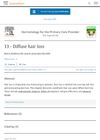The Alpha-Lipoic Acid Derivative Sodium Zinc Dihydrolipoylhistidinate Reduces Chemotherapy-Induced Alopecia in a Rat Model: A Pilot Study
April 2011
in “
Surgery today
”

TLDR A substance called sodium zinc dihydrolipoylhistidinate can significantly reduce hair loss caused by chemotherapy in rats.
In a pilot study from 2011 involving 40 Wistar rats, the α-lipoic acid derivative sodium zinc dihydrolipoylhistidinate (DHLHZn) was shown to significantly reduce chemotherapy-induced alopecia. The rats were divided into four groups of 10, with one group acting as a control and the other three receiving cytosine arabinoside (AraC) to induce alopecia and different concentrations of DHLHZn (0%, 0.5%, or 1%) applied topically. The study found that rats treated with AraC and 0% DHLHZn experienced complete hair loss, while those treated with 0.5% or 1% DHLHZn had significantly less hair loss. Histological analysis indicated that DHLHZn treatment reduced inflammatory cell infiltration in hair follicles caused by AraC. The study suggests that DHLHZn could be a potential therapeutic agent for chemotherapy-induced alopecia, but further research is needed to confirm its effectiveness and understand its mechanisms of action.






